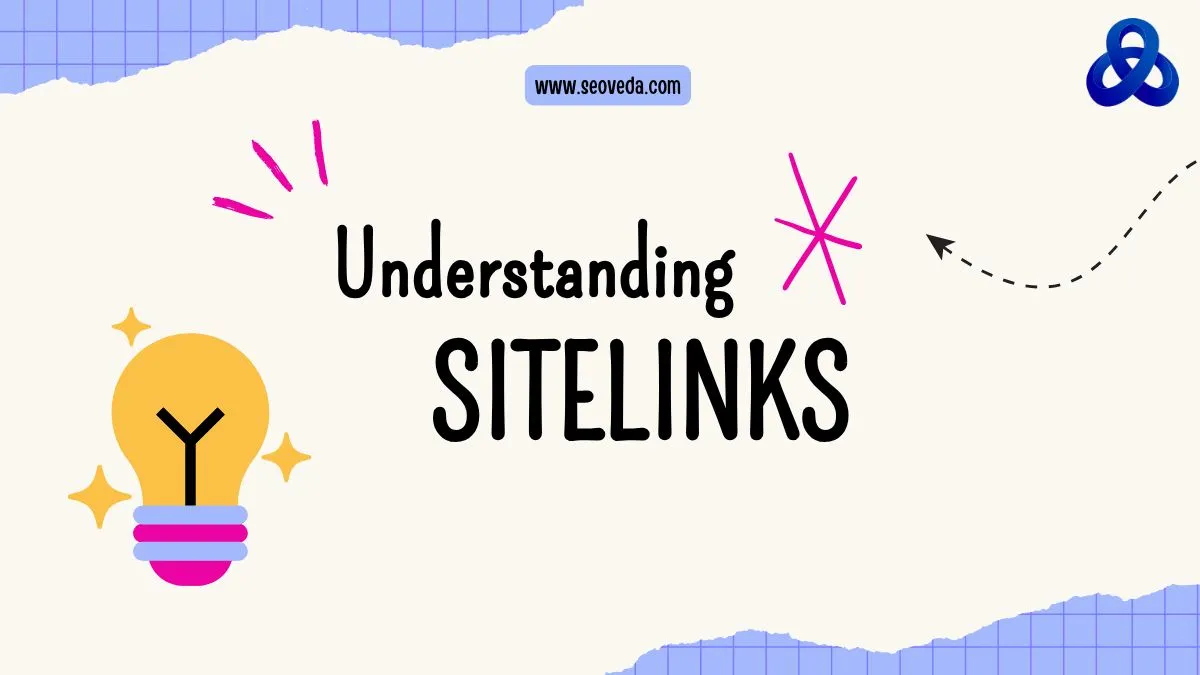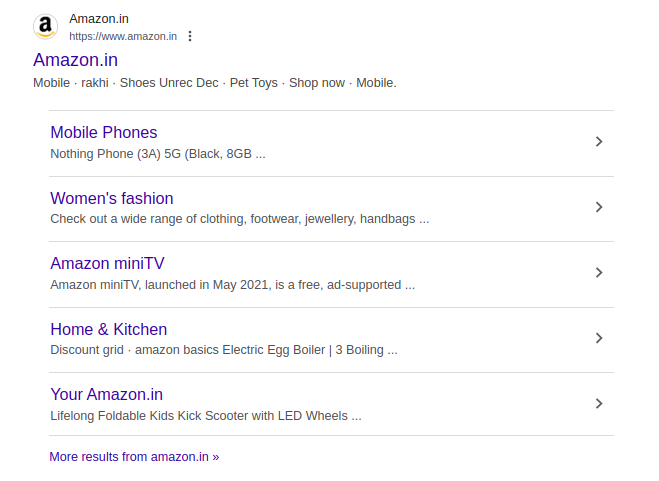Loading...
Loading...

Sitelinks are an important feature of SERPs that aid user experience and increase visibility for your website. This guide will look into the different types of sitelinks, the benefits for SEO, how to get sitelinks, and popular questions.
Sitelinks, a connecting form of links, are displayed in search engine results pages below the primary URL. They are designed to take users directly to a specific part of a website, to make valuable or important content easier to find and access. For example, if a user searched "Amazon," the sitelinks could be "Books", "Electronics", "Clothing", etc., which will link to specific categories below the major search result.
Below is an example of sitelinks. It will show when you search for a recognized brand or specific site:

This structure allows users to navigate directly to specific sections of the site, enhancing their search experience.
Sitelinks may fit into different categories and have different features and functions.
1. Automated Sitelinks
Automated sitelinks are generated by search engines based on the popularity, relevance & structure of the content. Algorithms often allow links to the subpages most worthy of supplying them in the sitelink, if a search engine feels sitelinks may benefit the site user. They may appear as horizontal (usually shows 2-6 links in a single line) or vertical (includes title & description) form.
2. Breadcrumb Sitelinks
Breadcrumb sitelinks present a hierarchy of navigation on a site and offer a hint to the site user. Breadcrumb sitelinks are generally hierarchical to the location of the current page on the website.
3. Video Sitelinks
In some cases, search engines will show sitelinks for a video page or specific video content, if video content exists, making it a type of sitelink specific to video content that improves visibility.
4. Product Sitelinks
Product or e-commerce sitelinks exist to link to a product or product category, allowing the user to find their correct solution as quickly as possible.
Sitelinks have many advantages for SEO, such as:
1. Increased Visibility
Like with ad extensions, sitelinks take up more SERP real estate, helping your site be more visible and stand out among competitors, which can potentially lead to greater click-through rates (CTR).
2. Improved User Experience
You are improving the user experience because you are providing direct links to exactly what users are looking for. Users no longer have to bounce there quickly to find what they are looking for, but are directly linked to what they need, which will lead to fewer bounces and more chances for conversions.
3. Increased Credibility
With sitelinks, you probably have increased your credibility, since when users see your site with sitelinks in search results, they will likely see your site/brand as credible, trustworthy, and authoritative.
4. Increased Convenience
Sitelinks offer users links to content they may be seeking without ever navigating through the site. They are provided the content they need without having to wade through the site to navigate to it. You can expect increased user engagement and retention.
5. Can Lead to Better Rankings
While sitelinks do not impact rankings directly, increased CTR and user engagement indirectly result in better ranking of your website.
While sitelinks cannot be achieved, there are ways to improve your chances of getting made:
1. Optimize your Website Structure
It is important that your website has a proper hierarchical structure so that search engines can understand that it is relevant. Make it clear what the categories are and use a proper hierarchical organizational structure (find a way to tier) to make it easier for users and search engines to find information.
2. Descriptive Anchor Text
Use descriptive anchor text for internal links to assist search engines in determining which pages are most important. This could help in creating relevant sitelinks.
3. Implement Schema Markup
Use schema markup to improve how search engines view your site’s content. If you use Schema Markup, you are utilizing structured data, helping search engines find relevance within the context of your pages.
4. Submit Sitemap
Provide an XML sitemap using Google Search Console. By doing so, you are helping search engine crawlers more easily crawl your relevant pages, helping them build the relevant pages for sitelinks.
5. Track and Adjust
Constantly monitor the overall performance of your website and make adjustments based on where you see search results. Use tools such as Google Search Console to see which pages are working best and so on.
1. What determines if my site will show sitelinks?
A variety of factors determine if sitelinks will be produced, including site structure, content relevancy, user interaction metrics, and so on. Well-structured sites with relevant content are more likely to receive sitelinks than poorly structured sites without engaging content.
2. Can I delete sitelinks?
You cannot delete sitelinks, though you can sort of independently influence their appearance in Google Search Console. You can remove certain pages from showing as sitelinks by demoting (reducing structural relevance/deleting) them.
3. Do sitelinks affect site ranking?
The sitelink itself does not count towards site ranking, but the advantage of CTR on your site from sitelinks may also increase rank over time.
4. How long does it take to get sitelinks?
There is no real timeline to ask the question 'how long?' It can vary based on site authority, site structure, and how frequently crawlers crawl your site, among other things.
5. Are sitelinks available for all websites?
No, sitelinks are more common for well-established websites with a clear structure. Smaller or newer websites may not qualify for sitelinks until they gain authority and visibility.
Sitelinks can be a powerful visibility and user experience tool in search results. By now, you should understand the types of sitelinks, the advantages of sitelinks, and what you can do to obtain sitelinks. Following suggested best practices and today’s recommendations to optimize your website properly can improve your chances of obtaining sitelinks, and, consequently, success online.